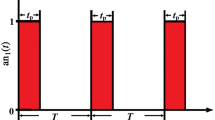Abstract
High-strength alloys can be efficiently welded utilizing laser beam welding because of their attributes, such as minimized fusion, heat-affected zone extensions, and minor deformation. Computational study of the laser material interaction process assists in analysing numerous process variables and their effect, which is challenging experimentally. This work developed a 3D numerical model for pulsed laser welding of high-carbon alloy steel. A hybrid 3D conical heat source model with a double ellipsoid and a 3D conical heat source model was employed to study laser–material interaction in the finite element modelling of the process. Post-processing of the simulation results for both the heat sources was compared to investigate the suitability of the volumetric heat source depicting experimental data. The analysis was carried out by comparing the models and calculating the dimensions of weld geometry for various process parameters. A suitable heat source for the weld geometry was identified using the isotherms. Commercial software (Comsol Multiphysics 5.6) is used to solve the conduction and heat flux equations using Finite Element Methods. By altering the welding speed at three different peak powers, the weld pool depth and width were calculated. The results were plotted and matched with the experimental data for the two different heat sources. Finally, the heat sources were compared to obtain the laser peak power for full-depth penetration of the weld joint. The simulations were further validated by comparing the experimental results of weld geometry at different laser peak power.







Similar content being viewed by others
References
Wang L, Wei Y, Zhan X, Yu F, Cao X, Gu C, and Ou W, J Mater Process Technol 246 (2017) 22.
Ragavendran M, Chandrasekhar N, Ravikumar R, Saxena R, Vasudevan M, and Bhaduri A K, Opt Lasers Eng 94 (2017) 27.
Lindgren L E, Comput Methods Appl Mech Eng 195 (2006) 6710.
Farias R M, Teixeira P R F, and Vilarinho L O, J Construct Steel Res 176 (2021) 106382.
Su H, Wu C S, Bachmann M, and Rethmeier M, Mater Design 77 (2015) 114.
Kik T, Materials 13 (2020) 608.
Kik T, and Górka J, Materials 12 (2019) 516.
Rosenthal D, J Fluids Eng 68 (1946) 849.
Swift-Hook D T, and Gick A E F, Weld J 52 (1973) 492s.
Goldak J, Chakravarti A, and Bibby M, Metall Trans B 15 (1984) 299.
Wu C, Wang H G, and Zhang Y M, Weld J New York 85 (2006) 284.
Chukkan J R, Vasudevan M, Muthukumaran S, Kumar R R, and Chandrasekhar N, J Mater Process Technol 219 (2015) 48.
Sahoo C K, Mallick S, Kumar K, and Masanta M, Sādhanā 46 (2021) 1.
Cui L, Fujii H, Tsuji N, and Nogi K, Scr Mater 56 (2007) 637.
Ascari A, and Fortunato A, Opt Laser Technol 56 (2014) 25.
Chung Y D, Fujii H, Ueji R, and Tsuji N, Scr Mater 63 (2010) 223.
Vora H D, Santhanakrishnan S, Harimkar S P, Boetcher S K, and Dahotre N B, Int J Adv Manuf Technol 68 (2013) 69.
Acknowledgements
We would like to thank the Ministry of Mines (Project Number Met4-14/6/2022) for financial support. We also thank, COMSOL team for their continuous technical support.
Author information
Authors and Affiliations
Corresponding author
Additional information
Publisher's Note
Springer Nature remains neutral with regard to jurisdictional claims in published maps and institutional affiliations.
Rights and permissions
Springer Nature or its licensor (e.g. a society or other partner) holds exclusive rights to this article under a publishing agreement with the author(s) or other rightsholder(s); author self-archiving of the accepted manuscript version of this article is solely governed by the terms of such publishing agreement and applicable law.
About this article
Cite this article
Sahoo, S., Mishra, R., Srivastava, N. et al. FEM Simulation of Pulsed Laser Welding of High-Carbon Alloy Steel: Using Different Heat Source Models. Trans Indian Inst Met 76, 3421–3427 (2023). https://doi.org/10.1007/s12666-023-03008-x
Received:
Accepted:
Published:
Issue Date:
DOI: https://doi.org/10.1007/s12666-023-03008-x




